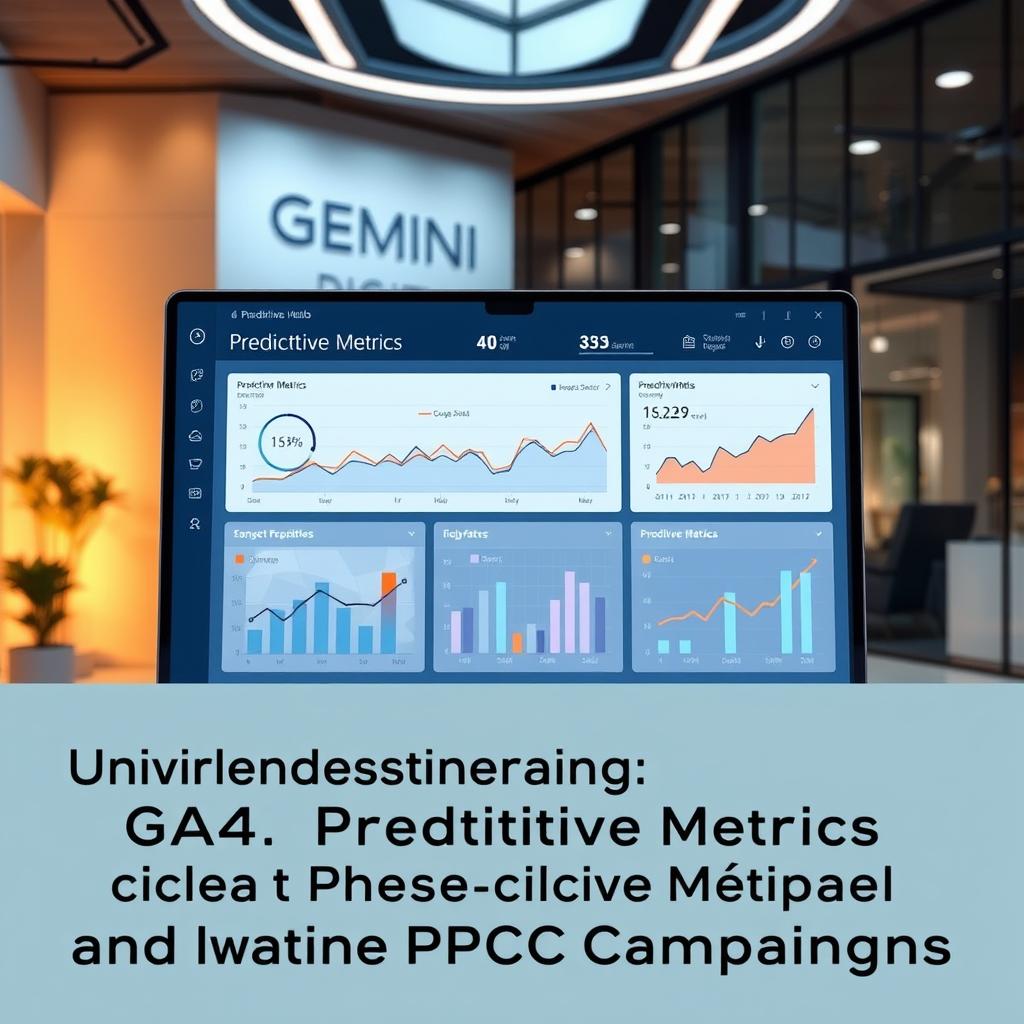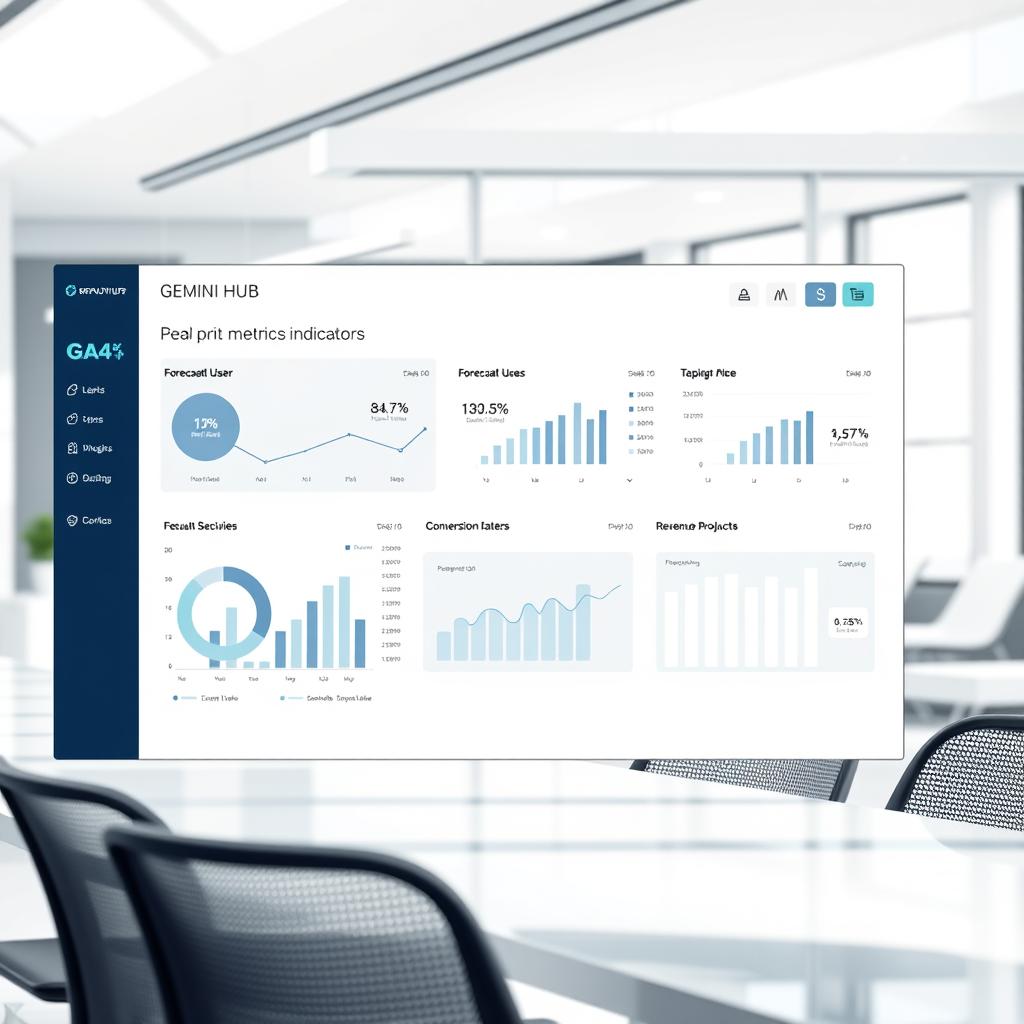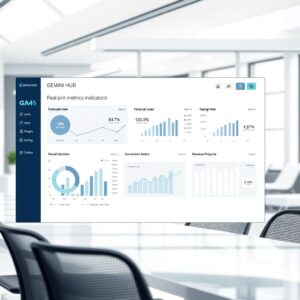Companies leveraging Google Analytics 4’s predictive metrics witness a 40% uptick in PPC conversion rates within the initial three months. This remarkable surge occurs when advertisers harness the power of machine learning to pinpoint and engage their most valuable prospects before they even realize they need to purchase.
Google Analytics 4 revolutionizes PPC targeting strategies with its advanced predictive analytics. It scrutinizes millions of data points to forecast user behavior, purchase intent, and customer value. This transition from reactive to proactive marketing enables advertisers to allocate budgets more effectively and connect with the right audiences at the ideal time.
Unlike traditional analytics tools that only reflect past events, GA4 predictive metrics offer a glimpse into the future. This forward-looking perspective empowers marketers to pinpoint users most inclined to convert, spend more, or churn. Equipped with these insights, PPC campaigns evolve from broad nets to precision instruments.
The advent of predictive analytics in PPC campaigns heralds a new chapter in digital advertising. Savvy marketers employ machine learning to forecast customer lifetime value, purchase probability, and churn risk. These metrics steer every decision, from audience segmentation to bid strategy optimization.
SEOteric Digital Marketing excels in deploying these cutting-edge strategies for businesses eager to elevate their PPC performance. Reach out at +1 (929) 989-3343 to uncover how GA4 predictive metrics can transform your advertising outcomes.
Key Takeaways
- GA4 predictive metrics can boost PPC conversion rates by up to 40% through machine learning insights
- Predictive analytics shifts marketing from reactive to proactive by forecasting user behavior before it happens
- Three main predictive metrics in Google Analytics 4 include purchase probability, churn probability, and predicted revenue
- Machine learning marketing identifies high-value audiences and optimizes budget allocation automatically
- Integration between GA4 and Google Ads enables real-time audience targeting based on predictive scores
- Successful implementation requires proper setup, data collection, and continuous optimization strategies
Understanding GA4 Predictive Metrics and Their Role in Modern PPC Campaigns

Google Analytics 4 introduces a new era in PPC advertising with advanced predictive modeling. These tools analyze user behavior to forecast future actions. This allows marketers to make informed decisions, transforming raw data into actionable insights.
What Are GA4 Predictive Metrics?
GA4 predictive metrics use machine learning to anticipate user actions. They examine historical data to predict conversions, purchases, or website exits. The system analyzes millions of data points to assign probability scores to users.
The core strength lies in conversion modeling that identifies high-value audiences before they act. This proactive approach replaces reactive strategies with data-driven targeting, maximizing campaign efficiency.
The Evolution from Universal Analytics to GA4’s Machine Learning Capabilities
The shift from Universal Analytics to GA4 marks a significant change in analytics philosophy. Universal Analytics focused on session-based tracking and historical reporting. GA4, on the other hand, uses user-centric measurement with predictive modeling features.
This evolution brings automated insights that once required complex manual analysis. The platform now delivers user behavior analysis through sophisticated algorithms that learn and improve over time.
Key Predictive Metrics Available in Google Analytics 4
GA4 offers three primary predictive metrics that transform PPC campaign management:
| Metric Name | Description | PPC Application |
|---|---|---|
| Purchase Probability | Likelihood of conversion within 7 days | Target high-intent users with increased bids |
| Churn Probability | Risk of user disengagement | Re-engage users with tailored messaging |
| Revenue Prediction | Expected purchase value in 28 days | Allocate budget to high-value segments |
These metrics enable precise audience segmentation based on predicted behaviors, not just past actions.
The Power of Machine Learning in PPC Advertising

The digital advertising world has seen a major shift with the introduction of machine learning in PPC campaigns. These advanced systems sift through millions of data points to spot patterns that humans might overlook. By examining user behavior, demographics, and engagement metrics, ai-driven marketing unlocks new heights of campaign success.
How AI-Driven Marketing Transforms Campaign Performance
Artificial intelligence is changing how advertisers manage campaigns. Machine learning models learn from user interactions, tweaking targeting in real-time. This adaptive method ensures ads hit the most engaged audiences at the best times.
Key transformations include:
- Automated bid adjustments based on user intent signals
- Dynamic ad creative optimization
- Real-time audience expansion
- Predictive budget allocation
Benefits of Predictive Analytics for PPC Campaigns
Predictive analytics for ppc campaigns brings about significant improvements in various performance areas. Advertisers employing these technologies see notable boosts in efficiency and effectiveness.
| Performance Metric | Traditional PPC | AI-Powered PPC | Improvement |
|---|---|---|---|
| Click-Through Rate | 2.5% | 4.2% | 68% increase |
| Cost Per Acquisition | $45 | $28 | 38% decrease |
| Conversion Rate | 3.1% | 5.7% | 84% increase |
| ROAS | 3.2:1 | 5.8:1 | 81% improvement |
Real-World Applications of Machine Learning Models in Advertising
Top companies are using ai-powered ad targeting to achieve outstanding results. Netflix, for example, uses predictive analytics to tailor promotional campaigns, boosting engagement by 75%. Amazon leverages machine learning to fine-tune product recommendations in sponsored ads, ensuring precise audience matching and driving conversions.
Retail giants like Target and Walmart are also harnessing predictive models to forecast seasonal demand, adjusting their PPC strategies. These systems analyze historical purchase data, weather patterns, and social trends to predict customer needs before they arise.
Setting Up GA4 for Predictive Analytics Success
Starting with predictive marketing analytics in GA4 demands a meticulous setup. The groundwork for optimizing PPC campaigns lies in the correct installation of tracking codes and event parameters. It’s essential for organizations to establish a solid data collection framework before tapping into GA4’s advanced machine learning capabilities.
The setup process includes several key steps:
- Enable enhanced ecommerce tracking across all product pages
- Configure conversion events that align with business objectives
- Set up data streams for website and app properties
- Define custom events for specific user interactions
- Establish audience triggers based on engagement patterns
Data quality is critical for the accuracy of user engagement models. GA4 necessitates at least 1,000 positive and 1,000 negative examples of each predicted behavior over 28 days. This ensures the machine learning models have enough data for reliable predictions.
Proper event configuration is the core of data-driven optimization strategies. Key events should mirror significant user actions like purchases, sign-ups, or content engagement. Each event must have clear parameters that capture essential context about user behavior.
Audience segmentation becomes more effective with detailed user data. Setting up user properties, custom dimensions, and engagement metrics creates rich profiles for predictive analysis. These detailed profiles allow GA4 to make accurate predictions about future user behavior, supporting advanced targeting strategies.
How to use GA4 predictive metrics for smarter PPC targeting
GA4’s predictive metrics revolutionize ppc audience targeting by leveraging machine learning to pinpoint conversion-prone users. These tools are readily available in the GA4 interface, empowering marketers to craft more effective campaigns. By analyzing user behavior, GA4 generates audience predictions that enhance campaign outcomes and minimize ad waste.
Accessing Predictive Audiences in GA4
To access predictive audiences, head to the Audience Builder in GA4’s left menu. Choose “Predictive” from the audience suggestions dropdown. GA4 provides three predictive metrics: purchase probability, churn probability, and revenue prediction. Each metric necessitates at least 1,000 positive and 1,000 negative examples over 28 days for reliable predictions in targeted advertising.
Creating Custom Audiences Based on Predictive Metrics
Construct custom segments by establishing probability thresholds aligned with campaign objectives. For instance, create a high-intent audience with users displaying 80% or higher purchase probability. Blend predictive scores with demographic data or past behaviors for enhanced targeting. This method facilitates personalized advertising that engages users at the most opportune moments.
Integrating GA4 Predictions with Google Ads
Connect GA4 to Google Ads through the admin settings to enable automatic audience import. Once linked, predictive audiences will appear in Google Ads within 24 hours. Utilize these segments for bid adjustments, targeting exclusions, or campaign-specific strategies. Data-driven ppc targeting strategies become more potent when guided by predictions, optimizing budget allocation.
Best Practices for Implementation
Update audiences weekly to ensure accuracy. Experiment with various probability thresholds to discover the most effective levels. Keep an eye on conversion rates and refine segments based on performance. Begin with small budget tests before scaling successful predictive audiences across campaigns.
Leveraging Purchase Probability for Enhanced Audience Targeting
Purchase probability revolutionizes how advertisers connect with consumers by pinpointing those most inclined to buy. This metric allows marketers to concentrate their resources on audiences with clear purchasing intentions. This strategy enhances campaign effectiveness and profitability.
Understanding Purchase Probability Scores
GA4 assigns a score from 0 to 100 to each user, indicating their purchase likelihood within seven days. These scores are based on predictive user behavior modeling, analyzing past actions and site interactions. A score of 75 signifies a 75% chance of conversion.
The scoring system considers various factors through customer behavior analysis:
- Pages viewed during sessions
- Time spent on product pages
- Cart additions and abandonments
- Previous purchase history
- Device and location patterns
Creating High-Intent Audience Segments
Smart segmentation involves grouping users by their probability scores. Those scoring above 50 are ideal targets for conversion forecasting campaigns. These segments exhibit behaviors like frequent product page views, cart additions, and site returns.
Optimizing Bid Strategies Based on Conversion Likelihood
Bid optimization becomes more precise with probability scores. Set automated rules to boost bids for users scoring 70 or higher. Maintain standard bids for those with moderate scores. This strategy maximizes ROI through smarter ad targeting techniques that focus on conversion prediction opportunities.
Maximizing ROI with Churn Probability Predictions
Churn probability metrics in GA4 provide deep insights for boosting advertising roi. They pinpoint users likely to disengage with your brand within seven days. This predictive tool changes how marketers tackle retention, opening doors for targeted efforts before users exit the conversion path.
Smart remarketing strategies use these predictions to craft campaigns that resonate with at-risk audiences. When GA4 flags users with high churn probability, marketers can send personalized messages, exclusive offers, or compelling content. This aims to rekindle interest and maintain user engagement.
Effective user behavior modeling through churn predictions allows for precise timing and messaging. Here are some proven strategies:
- Deploy time-sensitive offers to users showing early disengagement signals
- Create dynamic ad content that addresses specific pain points or abandoned actions
- Adjust bidding strategies to prioritize high-value users at risk of churning
- Implement sequential messaging that guides users back into the purchase funnel
| Churn Risk Level | Recommended Action | Expected Impact on ROI |
|---|---|---|
| High (70-100%) | Aggressive remarketing with incentives | 15-25% retention improvement |
| Medium (40-69%) | Personalized content campaigns | 10-15% retention improvement |
| Low (0-39%) | Standard engagement tactics | 5-10% retention improvement |
Data-driven decision making is key when budgeting across different churn segments. Customer journey mapping uncovers key touchpoints for effective intervention. This allows marketers to optimize spending and enhance campaign success.
Customer Lifetime Value Predictions for Strategic PPC Optimization
Smart marketers recognize that not all customers are created equal. By using customer lifetime value predictions in GA4, they can elevate their PPC campaigns. This shift moves from chasing clicks to focusing on long-term revenue through smart ad optimization.
Calculating and Understanding CLV in GA4
GA4 uses historical data and user behavior to predict customer lifetime value. It looks at purchase frequency, average order values, and engagement to forecast a user’s future worth. These predictions span 28 days but guide PPC strategies for months.
Targeting High-Value Customer Segments
Identifying the top 20% of users by predicted value is key. These high-CLV segments need targeted strategies with tailored messages and higher bids. Marketers can create special audiences in Google Ads for these users, ensuring they get the best offers.
Budget Allocation Based on Predicted Customer Value
Smart budgeting can greatly improve campaign results. Spending 60-70% on high-CLV segments boosts ROI while keeping a broad reach with the rest. This balanced strategy promotes growth and doesn’t overlook new customer acquisition. Regularly reviewing CLV predictions helps adjust budgets as the market changes.
Advanced Audience Segmentation Strategies Using Predictive Metrics
Smart marketers recognize the power of predictive ppc audience segmentation for campaign optimization. By blending various data layers, businesses can craft hyper-focused groups that resonate with targeted advertising. This strategy elevates basic targeting to precision marketing, yielding tangible results.
Creating Multi-Layered Audience Segments
To build sophisticated segments, predictive metrics must be combined with demographic and behavioral patterns. Marketers can layer purchase probability scores with predicted customer lifetime value to pinpoint top prospects. This method enables the creation of segments such as:
- High-value customers likely to buy within 7 days
- Medium spenders showing increased engagement signals
- At-risk customers with high future value
Combining Behavioral Data with Predictive Scores
The synergy between behavioral patterns and predictive analytics is transformative. A visitor who viewed five product pages and has a 75% purchase probability merits different treatment than someone with similar behavior but low purchase intent. Advertisers adeptly adjust bids, messaging, and creative elements for each segment.
Cross-Channel Attribution and Audience Signals
Customer journeys across multiple touchpoints unveil valuable audience signals for optimization. Cross-channel attribution uncovers which paths lead to conversions, guiding marketers to optimize budget allocation.
| Channel Sequence | Conversion Rate | Recommended Action |
|---|---|---|
| Social → Email → Search | 12.4% | Increase social ad spend |
| Direct → Display → Search | 8.7% | Boost remarketing budget |
| Search → Email → Search | 15.2% | Enhance email sequences |
Optimizing PPC Campaigns with Data-Driven Decision Making
Successful data-driven marketing hinges on continuous improvement and adaptation. Savvy advertisers rely on predictive metrics to inform every decision, from budget allocation to creative selection. This method elevates traditional campaign management into a high-tech optimization engine.
Online advertising optimization thrives on ongoing testing cycles. Marketers should set regular review periods to evaluate predictive metric performance. Weekly assessments help teams identify trends early and tweak strategies before budget waste. Each review session delves into audience behavior, conversion rates, and cost efficiency across various segments.
Machine learning PPC applications go beyond simple bid tweaks. Intelligent systems sift through thousands of data points to suggest optimal ad schedules, device targeting, and geographic focus. These insights enable campaigns to target the right users at the ideal time, boosting conversion rates while cutting costs.
| Optimization Area | Traditional Approach | AI-Powered Method | Performance Gain |
|---|---|---|---|
| Bid Management | Manual CPC adjustments | Predictive bid optimization | 35% cost reduction |
| Creative Testing | A/B split tests | Multi-variant predictions | 28% CTR increase |
| Audience Selection | Demographic targeting | Behavioral scoring models | 42% conversion lift |
| Landing Pages | Single page testing | Dynamic page selection | 31% bounce rate decrease |
AI-driven PPC campaigns adjust in real-time to market shifts. As user behavior evolves, predictive models swiftly tweak targeting parameters. This agility ensures campaigns stay at peak performance, even with seasonal changes, competitive pressures, or economic shifts. Regular analysis of these adjustments offers valuable insights for future campaign planning and ad targeting optimization strategies.
Measuring Success and Continuous Improvement
Tracking performance and refining strategies are key to maximizing predictive PPC campaigns’ impact. Smart marketers rely on data-driven insights to continually enhance their campaigns. They leverage AI for PPC optimization, ensuring campaigns yield better results with each iteration.
Key Performance Indicators for Predictive PPC Campaigns
Success in AI-powered advertising hinges on monitoring specific metrics. These metrics reveal campaign effectiveness. Key KPIs include:
- Prediction accuracy rates showing how well the system identifies likely converters
- Audience quality scores measuring engagement levels
- Incremental conversion lift compared to standard targeting
- Cost per acquisition changes over time
- Return on ad spend improvements
A/B Testing Strategies for Predictive Audiences
Testing different approaches is vital for identifying optimal strategies for anticipating user intent for PPC. Conduct controlled experiments comparing predictive audiences with traditional targeting methods. Test variables like bid adjustments, ad creative, and landing pages to enhance personalized user experiences.
Analyzing Campaign Performance and ROI
Regular analysis uncovers opportunities for improvement in marketing attribution strategies. Review performance data weekly to identify trends and adjust tactics. Focus on metrics that directly impact business goals, such as conversion rates and customer acquisition costs. Use these insights to refine audience segments and bidding strategies for enhanced results.
Conclusion
GA4 predictive metrics have revolutionized PPC campaign strategies. They offer deep insights into customer behavior and buying habits. Companies adopting ai-driven ppc optimization witness substantial performance boosts. This shift from traditional analytics to predictive models heralds a new digital advertising era.
Machine learning for ppc unlocks new possibilities. Predictive audiences enable marketers to target the right audience at the right time. Data-driven attribution reveals which interactions lead to conversions. These tools forge smarter, more effective campaigns, achieving better outcomes with less effort.
Mastering GA4 predictive metrics demands expertise and continuous improvement. Collaborating with specialists like Gemini Digital Hub can expedite your PPC performance enhancement. Their team excels in deploying these advanced tools. Reach out at +1 (929) 989-3343 to begin transforming your campaigns with predictive analytics.
The future of PPC advertising is for those who leverage data wisely. GA4’s predictive tools empower marketers to thrive in today’s digital environment. Companies that invest in these technologies will secure a lasting competitive advantage.
FAQ
What are GA4 predictive metrics and how do they work for PPC campaigns?
GA4 predictive metrics use machine learning to forecast user actions. They include metrics like purchase probability and revenue predictions. These help advertisers target high-value audiences for their campaigns. The metrics score users based on their conversion likelihood, from 0-100.
How long does it take for GA4 to generate accurate predictive audiences?
GA4 needs historical data to make reliable predictions. You need at least 1,000 users who triggered a conversion event and 1,000 who didn’t within 28 days. This usually takes 30-60 days after setup for accurate predictive modeling.
Can predictive metrics improve advertising ROI for small businesses?
Yes, predictive metrics can greatly improve ROI for all businesses. Small businesses can allocate budgets more efficiently by targeting high-conversion users. Agencies like SEOteric Digital Marketing report 20-40% cost per acquisition reductions through AI targeting.
How do I integrate GA4 predictive audiences with my Google Ads campaigns?
First, link your GA4 property to Google Ads. Then, import predictive audiences through the Audience Manager. Create segments in GA4’s Audience Builder based on predictive scores. Publish these to Google Ads and enable automated bid strategies for better performance.
What’s the difference between purchase probability and conversion modeling in GA4?
Purchase probability predicts a user’s purchase likelihood in the next 7 days. Conversion modeling estimates conversions when direct data is restricted. Purchase probability relies on actual behavior, while conversion modeling uses algorithms for estimation.
How can I use customer lifetime value predictions for budget allocation?
Use CLV predictions to identify your most valuable users. Allocate 60-70% of your PPC budget to the top 20% CLV scores. Create campaigns for high-CLV segments with premium bids. Adjust remarketing based on long-term value, not just immediate conversions.
What are the best practices for creating predictive audience segments?
Effective segmentation combines predictive metrics with behavioral data. Start with purchase probability thresholds above 50 for immediate campaigns. Add CLV predictions and demographic data for better targeting. Refresh audiences every 7-14 days and test different thresholds. Use customer journey mapping to understand user paths.
How do I measure the effectiveness of predictive metrics in my PPC campaigns?
Track prediction accuracy, audience quality scores, and conversion lift. Compare campaigns with predictive audiences to traditional targeting through A/B testing. Monitor cost per acquisition reduction, conversion rate improvements, and ROI increases. Agencies like W3era Web Technology use attribution models to show campaign improvements.






